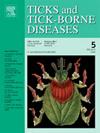Spatial distribution and clustering of medically important tick species in Illinois: Implications for tick-borne disease risk
IF 3.4
2区 医学
Q2 INFECTIOUS DISEASES
引用次数: 0
Abstract
The geographic range of medically significant tick species has expanded across the United States, with Illinois experiencing increased tick populations and incidence of tick-borne diseases (TBDs) in recent decades. This study investigated the spatial distribution of three tick species: Amblyomma americanum (lone star tick), Dermacentor variabilis (American dog tick), and Ixodes scapularis (blacklegged tick) in Illinois, using data collected through active surveillance from 2018 to 2022. A total of 476 records of 1414 ticks were analyzed. Spatial analytical techniques, including species distribution mapping, Inverse Distance Weighted (IDW) interpolation, Hot Spot (Getis-Ord Gi*), and Cluster and Outlier (Anselin Local Moran’s I) analyses, were applied to identify distribution patterns and statistically significant local clusters. The species distribution mapping results revealed distinct geographic patterns: A. americanum was most prevalent in southern, D. variabilis in central and southern, and I. scapularis in central and northeastern Illinois regions, respectively. With agreement between Hot Spot and Cluster-outlier analysis, counties with significantly high tick prevalence were identified, including 10 counties for A. americanum in southern Illinois, four counties for D. variabilis in central and southern Illinois, and seven counties for I. scapularis in central and northeastern Illinois. The study results correspond with incidence of TBDs reported to the Illinois Department of Public Health (IDPH), including ehrlichiosis, Rocky Mountain spotted fever, Lyme disease, and anaplasmosis. These findings provide insights into the geographic variability of tick distributions, emphasizing the importance of targeted public health strategies and tick control efforts to mitigate the burden of TBDs in Illinois.
伊利诺伊州医学上重要蜱类的空间分布和聚集:对蜱传疾病风险的影响
在美国,具有重要医学意义的蜱虫物种的地理范围已经扩大,近几十年来,伊利诺伊州的蜱虫种群和蜱媒疾病(tbd)的发病率都在增加。本研究利用2018年至2022年通过主动监测收集的数据,调查了伊利诺伊州三种蜱的空间分布:Amblyomma americanum(孤星蜱),Dermacentor variabilis(美国狗蜱)和Ixodes scapularis(黑腿蜱)。共分析了1414只蜱的476条记录。利用物种分布图、IDW插值、热点分析(Getis-Ord Gi*)和聚类与离群分析(Anselin Local Moran’s I)等空间分析技术,对物种分布格局和具有统计学意义的局部聚类进行了识别。物种分布图显示出明显的地理分布格局:美洲蠓分布于伊利诺伊州南部,变异蠓分布于伊利诺伊州中部和南部,肩胛骨蠓分布于伊利诺伊州中部和东北部。热点分析与聚类异常值分析结果一致,确定了蜱虫流行率较高的县,其中南部有10个县为美洲伊蚊,中部和南部有4个县为变异伊蚊,中部和东北部有7个县为肩背伊蚊。研究结果与伊利诺斯州公共卫生部(IDPH)报告的tds发病率一致,包括埃利希体病、落基山斑疹热、莱姆病和无形体病。这些发现为蜱分布的地理变异性提供了见解,强调了有针对性的公共卫生战略和蜱控制工作对减轻伊利诺伊州tbd负担的重要性。
本文章由计算机程序翻译,如有差异,请以英文原文为准。
求助全文
约1分钟内获得全文
求助全文
来源期刊

Ticks and Tick-borne Diseases
INFECTIOUS DISEASES-MICROBIOLOGY
CiteScore
6.90
自引率
12.50%
发文量
185
审稿时长
6-12 weeks
期刊介绍:
Ticks and Tick-borne Diseases is an international, peer-reviewed scientific journal. It publishes original research papers, short communications, state-of-the-art mini-reviews, letters to the editor, clinical-case studies, announcements of pertinent international meetings, and editorials.
The journal covers a broad spectrum and brings together various disciplines, for example, zoology, microbiology, molecular biology, genetics, mathematical modelling, veterinary and human medicine. Multidisciplinary approaches and the use of conventional and novel methods/methodologies (in the field and in the laboratory) are crucial for deeper understanding of the natural processes and human behaviour/activities that result in human or animal diseases and in economic effects of ticks and tick-borne pathogens. Such understanding is essential for management of tick populations and tick-borne diseases in an effective and environmentally acceptable manner.
 求助内容:
求助内容: 应助结果提醒方式:
应助结果提醒方式:


